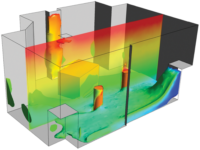Commercial HVAC systems are some of the most expensive and critical engineered systems used in buildings today. Building owners, developers, and their tenants are demanding more cost-effective and cost-efficient equipment performance while ensuring comfortable environmental conditions as each season changes.
HVAC systems are becoming smarter and more integrated to help maximize long-term performance and value. Building owners and facility managers are constantly on the lookout for new tools that can more effectively reduce repair costs, minimize downtime, and keep the operating environment in their buildings in optimum condition.
In turn, HVAC equipment manufacturers have been improving HVAC enclosure designs to be more energy efficient. These enclosures are not perfectly sealed boxes, however. They include doors and removable panels that are often quite large and which require maintenance and repair access as well as other activities. HVAC manufacturers and enclosure designers are installing thicker doors and panels with more insulation to help improve thermal efficiency and prevent heat from transferring through the door, enabling the unit to handle the heating/cooling load while tightly controlling the HVAC system’s energy demands.
As the designs and physical construction of these doors have changed, there is a need for new latching and hinging technology that can improve access to these enclosures and help HVAC equipment suppliers satisfy their end-use customers.
Engineering HVAC Energy Efficiency
Just as our modern world depends on complex systems, such as data centers, cell phone towers, and switching equipment, our built environment depends on high-performance HVAC units, the majority of which need to operate efficiently 24/7. Commercial HVAC units keep our workplaces, retailers, hospitals, schools, travel terminals, and a myriad of other locations comfortable and supplied with fresh air whenever in use.
These systems share several other characteristics: They use expensive, high-technology equipment that heat and/or cool vast volumes of air to precisely controlled temperatures and then move that air continuously, making them major energy consumers. According to the U.S. Department of Energy’s (DOE’s) studies of commercial buildings, HVAC equipment typically accounts for 39% of a building’s energy usage1.
For building owners and facilities managers focused on controlling costs, improving margins and keeping tenants happy, maximizing the energy efficiency of their HVAC systems is a key imperative. That means they will be looking to HVAC system suppliers who are improving the efficiency of their systems.
HVAC units are installed within enclosed, climate-controlled spaces as well as outside the building, often on rooftops. Major HVAC manufacturers typically design and fabricate their own enclosures; however, there is a second tier of enclosure manufacturers that make multiple components and supply them to HVAC manufacturers. Both types of manufacturers have begun to redesign their enclosures, focusing on improving the efficiency of the enclosure by improving the level of insulation.
Improving Enclosure Access Door Designs
Enclosure access doors are one of the key areas where leakage can develop, so the industry is updating access door technology to reduce energy loss from two kinds of leakage: infiltration and exfiltration. Infiltration is leakage of unconditioned air into the HVAC unit from outside the enclosure. Exfiltration is leakage of air, typically conditioned air, from inside the unit through the casing to the outside. Both types of leakage increase the amount of energy required to supply conditioned air to the space.
Enclosure access doors are using thicker panels with improved insulation to reduce heat transfer through the door itself. Newer generation access doors are typically double-walled and insulated, with the total thickness of the door usually ranging from 50-75 millimeters. Now, some access doors have thicknesses up to 100 millimeters. These double-panel doors are typically constructed of two separate panels with a thick layer of foam insulation in between. Depending on the door size, they typically weigh between 35-50 pounds.
Some doors are just standard panels that open to allow access to control equipment; others are full, man-sized doors that enable personnel to enter the enclosure. There are even some very large panels, designed to be removable, that facilitate access to large pieces of equipment inside. Using thicker access doors with more insulation in these applications promotes a high perception of quality and creates important competitive value for HVAC system providers.
Securing Larger Doors
For any door to work, it needs a secure latching system and sturdy, reliable hinges. Larger, heavier enclosure doors need more robust latching and access control solutions. If not properly equipped, doors can become weak points in the enclosure envelope.
Regardless of size, the door still needs to close securely to create a near-airtight seal to prevent leakage. Insulated doors typically have a layer of closed-cell foam material or a compressible rubber bulb applied around the door opening which functions as a gasket to create a secure seal. While standard latching mechanisms were used to secure older enclosures with single sheet metal doors, newer double-skin doors require a different type of latching solution capable of securing a door panel between 25-75 millimeters and up to 100 millimeters thick.
The most appropriate solution for this is a compression latch, which holds a panel or cover closed with a cam and, at the same time, compresses a gasket around the inside of the door to seal it. A key challenge in selecting these latches is an unavoidable fact: The latch handle has to penetrate the door, creating a hole through the insulated wall.
One way to reduce the possible heat loss is to select latches with handles with a minimal design footprint to reduce the size of the hole that must go through the panel. Another design consideration is thermal conductivity connectivity and choosing latches that incorporate non-metallic insulating components can help to provide a thermal break. There are a number of component manufacturers currently investigating these solutions.
While a compression latch is the right solution for a double-walled door panel with insulation, improper installation of the latch could squeeze the insulation too much, damaging the foam and creating a void that could reduce the insulating factor. There are specialty cam latches designed to avoid this problem that can be firmly attached to the door without squeezing the foam insulation when closed.
In some cases, these doors have very large dimensions, so a single latch may not be sufficient to fully secure the door. Multipoint latching systems — which allow multiple latch points at the top, bottom, and middle of the door to be controlled by one actuator — can provide a simplified access solution for oversized doors.
When selecting a cam or compression latching solution for any enclosure door, it is important to take the following design requirements into consideration:
• Environment — With the majority of HVAC equipment located outside, enclosure OEMs must ensure that their equipment meets environmental protection and durability requirements. Enclosure OEMs can maintain compliance by incorporating latches that are tested to UL, NEMA, or IP standards.
• Safety — The interior of HVAC enclosures containing fans blowing air into and out of the equipment can generate a high level of pressure that can be harmful to maintenance technicians if they open the door quickly. There are latching systems that, when first actuated, allow the air to be slowly released, so that the high pressure building inside the enclosure does not force the door open too quickly. The operator can then actuate the latch a second time to safely access the enclosure.
• Ease of use — A simple opening is an important ergonomic characteristic, especially to maintenance technicians servicing large facilities, such as warehouses, production facilities, hospitals, business parks, and other multibuilding locations. Being able to access the enclosure door with simple tools creates a positive user experience and an overall impression of quality and value for the entire HVAC system.
Intuitive Enclosure Access
Like latches, hinges are an essential access component in the overall design of the HVAC enclosure, but they go beyond simply joining the panel to the frame. While relatively simple in terms of functionality, the technical capabilities of the latest hinge technology provide design engineers with new options for enhancing the performance of and interaction with panel doors.
It’s often the case that when maintenance technicians open an enclosure door, they want it to stay open while they access and work on a control panel or perform equipment maintenance. Rather than attach an external secondary door stay to prop it open, detent hinges allow a door to open to a preset angle and click into position.
Constant torque hinges fulfill the same function with a greater range of possibility, providing smooth opening operation and infinite positioning of the door, opening as far as a technician desires, and remaining in position until pushed close. These hinges allow for intuitive movement of the door, holding it at any point throughout the full range of motion when stopped and with the amount of effort required to move the door just enough to respond to deliberate motion.
In addition to opening, in certain HVAC systems, large doors may also need to be easily removed to accommodate the replacement or upgrade of large equipment. There is a range of removable hinges available that have been engineered for very simple removal without the need for separate tools, allowing a door to be “lifted off” its frame. As with the latching solutions and hinges previously mentioned, HVAC equipment OEMs and enclosure suppliers should select hinges that comply with standards for external use environments and provide durability and long operating life when exposed to the elements.
Selecting the Right Components
HVAC enclosure designers need to select the appropriate latching and hinging solutions that will satisfy two basic functional requirements: easy opening and secure closing.
Component selection should be based on a door’s dimensions, thickness, and weight. This includes choosing the proper number of hinges for the door’s size and determining whether a standard latch with just one latching point or a multiple latch configuration is required.
It‘s also important to work with a component supplier whose products are certified to comply with industry standards, such as IP65 and NEMA4. Since the majority of enclosures are outdoors, these certifications ensure products will withstand the weathering and corrosion that comes with exposure to the elements.
When choosing a high-volume supplier of latching and hinging solutions, HVAC designers should evaluate the strength of a vendor’s supply chain. The best suppliers are typically equipped with a strong supply chain and ample product available to meet production requirements. They will also be able to supply expert support and advice on the best latching and hinging technology to use on specific enclosure designs — especially those with insulated doors that call for access solutions engineered specifically for those applications.
As HVAC OEMs continue to improve the design and energy efficiency of their enclosure systems, selecting the appropriate latching and hinging solutions to complete those designs can help achieve the overall efficiency, energy savings, and improved performance the latest generation of HVAC systems are engineered to provide.
References
1. Energy Information Agency, 2001. Commercial Buildings Energy Consumption Survey. Washington, D.C.: U.S. Department of Energy.





